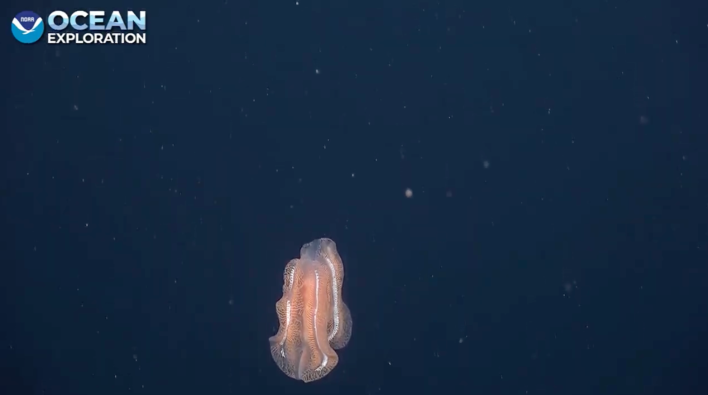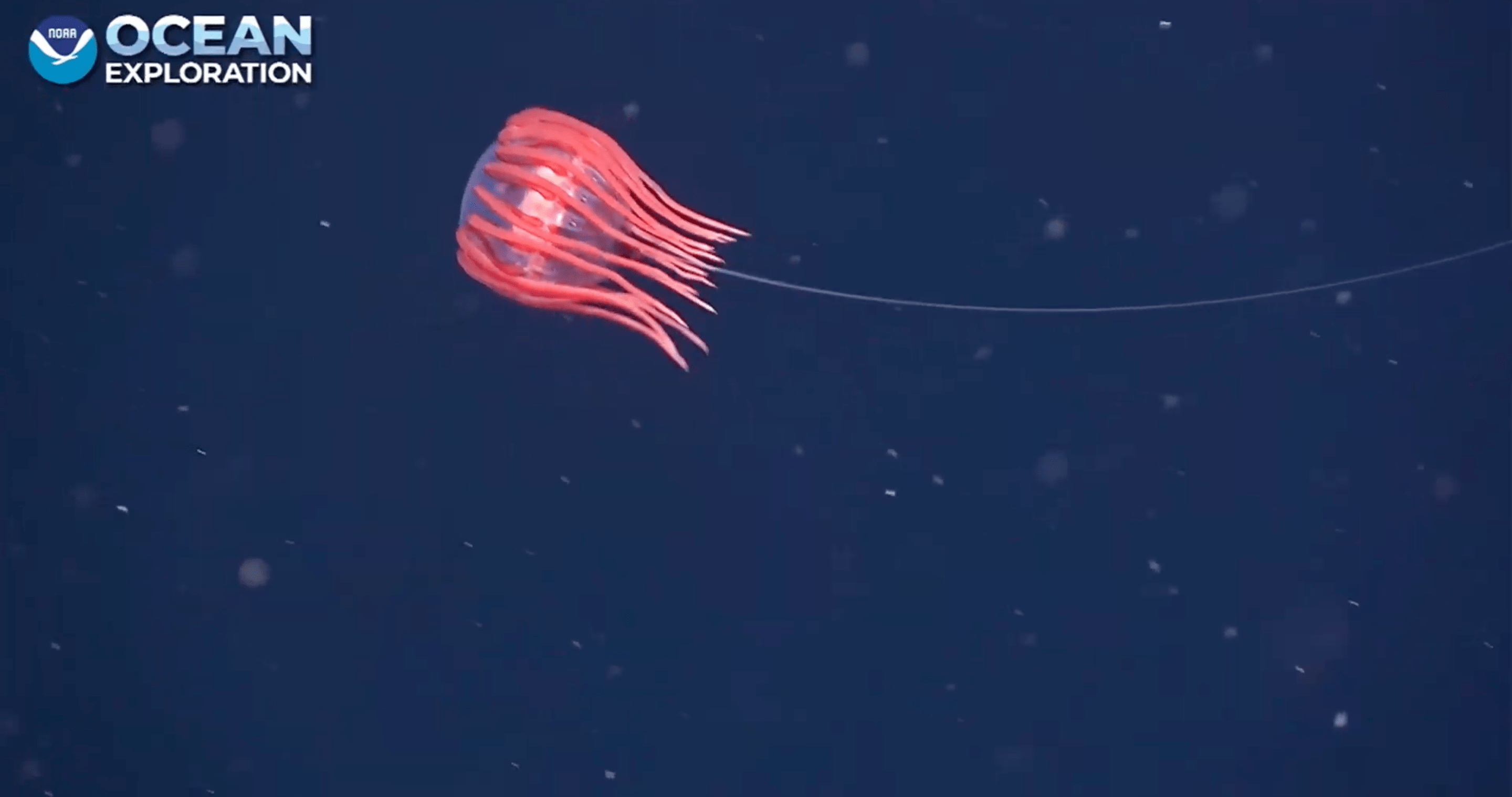My favorite reality TV happens at least 800 feet underwater. It is a big-budget production—the deep sea is not cheap to explore—but there is admittedly little in the way of plot. The premise of the National Oceanic Atmospheric Administration's Okeanos Explorer's deep-sea livestream is simple: Drop a remotely operated vehicle, or ROV, deep in the ocean and see who's hanging. It's like if Terrace House and Blue Planet and Twitch had a baby, and that baby had something called a slurp nozzle.
Sometimes celebrities show up: In 2021, the Okeanos ROV glimpsed the ethereal bigfin squid Magnapinna, a species that has only been seen about a dozen times since it was described a few decades ago. Sometimes the livestream makes a scientific discovery in realtime: In 2020, a Schmidt Ocean Institute ROV filmed an elusive ram's horn squid swimming with its head upright when scientists had long suspected the squid swam butt-up. But in my opinion, the real magic of the deep-sea livestream comes from the mundane, smaller characters that drift by. The ROV offers us a tiny peek into a world that is so utterly unlike our own that even the ordinary dramas of the tiniest creatures becomes fantastical. The deep-sea livestream is an hours-long ode to the weirdest little guys on the planet.
Okeanos is livestreaming dives from its Voyage to the Ridge 2022 expedition from 6:45 a.m. to 5 p.m. ET every day this week until July 29, and then again from August 7 to August 29. Last Friday's livestream was conducted in the water column above the Mid-Atlantic Ridge north of the Azores, and featured a steady supply of weird little guys. There were giant larvaceans, tadpole-like animals that cocoon themselves inside mucus mansions of their own excretion. There may have been a Planctoteuthis—a squid with a highly embellished tail that appears to mimic a siphonophore, a squishy order of animals that are both individual organisms and colonies. There was a mysterious ctenophore that looked like a Louis Comfort Tiffany vase, which was promptly vacuumed into the slurp nozzle.
As far as parts of the ocean go, the water column—the vast, vertical expanse of water between the surface and the seafloor that also happens to be the largest habitat on the planet—is famous for being fairly empty. But this emptiness puts a special spotlight on little guys. Obviously little guys live everywhere on the planet, but the open water makes them particularly easy to spot. A coral reef has so many little guys that one can only take them all in as a vista or community, and they're easily eclipsed in our attention when something as charismatic as an octopus wanders by. But in the open waters of the deep sea, a vast expanse of mostly nothing, an ROV can travel for minutes without seeing something large enough to distinguish as life. Even the tiniest worm becomes important and worth noticing. The open water is where little guys become the stars of the show.
This is true of life on land, too. A field that might look empty to us probably teems with bugs. A concrete parking lot houses innocuous green sprouts erupting from its cracks. A clean-looking human face contains vast societies of mites that live for just a few weeks, feasting on sebum and doing who knows what with their newly discovered anuses. Sometimes, when I am looking at my friends during a casual conversation, I know that I am also looking at their mites, and I wonder if any of their mites are looking back at me.
Encountering literally anything in the water column is serendipitous. Anything can be a discovery. A shrimp can be a discovery. So can a worm, or a jellyfish. Every copepod, perhaps the most abundant single species on the planet, that happens to wriggle across the video is named and remarked upon. And amid the constant drizzle of marine snow, meaning the bits and gobs of dead flesh and detritus falling from the surface, blobs of mucus, flesh, or dirt often masquerade as little guys. These cases of mistaken identity serve to heighten the stakes. So when a tiny constellation of white specks turns out not to be a mysterious shred of goo but actually a gelatinous invertebrate called a ctenophore—even if the livestream has filmed dozens of ctenophores already—I feel a sense of triumph. Even the tiniest distant speck might be alive; the camera need only zoom in.

The Okeanos deep-sea livestream also features narration so soothing it borders on ASMR. There will always be a scientist or two explaining what you're seeing on screen—what it is, how it lives, and what it's doing. This narration also serves as a constant reminder of the limits of our knowledge about the deep sea. "What am I looking at?" is an incredibly common refrain, one that often goes unanswered.
And when the serenity of the livestream is disrupted, it is often for downright Shakespearean drama. The Okeanos livestream occasionally records acts of killing, one creature feasting upon another creature. And unlike anything on Shark Week, these acts of predation can happen on tiny scales. Friday's dive captured a very, very hungry crustacean called an amphipod going to town on a bioluminescent ctenophore, producing a dazzling mukbang.
Even though the scientists who commentate on the livestream are experts of the biodiversity in these regions, and often have other experts on standby to offer precise identifications, some creatures inevitably elude identification, drifting offscreen to live out the rest of their lives with a level of privacy we can only dream of. It's admittedly pretty iconic to be something so gelatinous and confusing that you can drift toward a video screen, make a bunch of scientists go, "What the heck?", and then wriggle away. In an age where drones and wildlife cameras are bringing surveillance to nature, animals are losing their rights to digital privacy. But the beauty of the NOAA Okeanos livestream is that it does not intrude for long in the lives of animals it glimpses. (Except, of course, the ones that are captured with the slurp nozzle so scientists can study them.)
Today's Okeanos stream is exploring an axial ridge—where the earth's crust is born and new seafloor is formed—that features many corals and sponges, which, as animals and not plants, are certified little guys. The feed has already glimpsed a chimaera, also known as a ghost shark, which is neither a ghost nor a shark but still a very intriguing animal. You can watch the stream here. So, this week if you need to relax and unwind from the onslaught of generally terrible shit on dry land, I recommend tuning into the Okeanos livestream and chilling out, one copepod after another.






